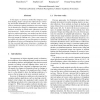Free Online Productivity Tools
i2Speak
i2Symbol
i2OCR
iTex2Img
iWeb2Print
iWeb2Shot
i2Type
iPdf2Split
iPdf2Merge
i2Bopomofo
i2Arabic
i2Style
i2Image
i2PDF
iLatex2Rtf
Sci2ools
ICCV
2003
IEEE
2003
IEEE
Multiple-cue Illumination Estimation in Textured Scenes
In this paper, we present a method that integrates cues from shading, shadow and specular reflections for estimating directional illumination in a textured scene. Texture poses a problem for lighting estimation, since texture edges can be mistaken for changes in illumination condition, and unknown variations in albedo make reflectance model fitting inpractical. Unlike previous works which all assume known or uniform reflectance, our method can deal with the effects of textures by capitalizing on physical consistencies that exist among the lighting cues. Since scene textures do not exhibit such coherence, we use this property to minimize the influence of texture on illumination direction estimation. For the recovered light source directions, a technique for estimating their intensities in the presence of texture is also proposed.
Albedo Make Reflectance | Computer Vision | Directional Illumination | ICCV 2003 | Illumination Condition | Illumination Direction Estimation | Texture Edges |
| Added | 15 Oct 2009 |
| Updated | 15 Oct 2009 |
| Type | Conference |
| Year | 2003 |
| Where | ICCV |
| Authors | Yuanzhen Li, Stephen Lin, Hanqing Lu, Heung-Yeung Shum |
Comments (0)

